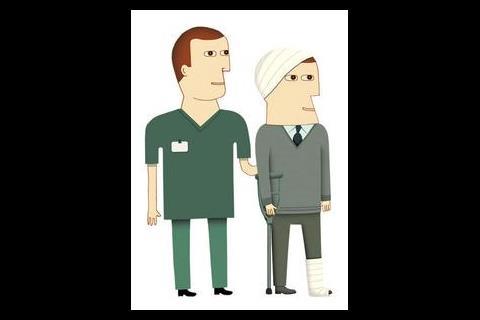Doctors surgeries are in a bad way. Old buildings, restrictive tenancies and lack of investment have driven doctors away from where they’re needed most. The new LIFT initiative aims to change all that.
Of all patient contact, the majority – over 90% – occurs in general practice. A survey of primary care in inner cities by the National Health Service revealed that many of the deprived urban areas, where health need is greatest, suffer from a disproportionately high number of sub-standard premises.
There is a large and diverse range of primary healthcare facilities in England. There are around 27 000 GP practitioners; 10 000 pharmacies; 17 000 dental practitioners and 7 000 opticians. The majority of GP’s premises are privately owned. Only around 16% of GPs premises are owned by NHS Trusts. This is a key issue in delivering good healthcare where it is needed most.
Doctors face significant disincentives to practising in inner cities. When renting premises, they can face restrictive long-term leases, or if they decide to purchase a property there is a high risk of negative equity. Often, the premises which are available are poor quality and not fit for purpose.
The quality of buildings at the cutting edge of healthcare delivery is shoddy. Not only are the buildings old and in poor condition, little planning has gone in to how services are delivered:
- only 40% of primary health care facilities are purpose built;
- almost half are adapted residential buildings or converted shops;
- less than 5% of GPs premises are co-located with a pharmacy;
- around 80% are below the recommended size.
The National Health Service is undergoing its greatest improvement since it was established in the 1940s. Clearly, upgrading and replacing GP surgeries and related services is a crucial part of this. Initiatives such as PFI and ProCure 21 are aimed at large hospital buildings. A programme launched to fund and manage procurement of smaller primary healthcare buildings is LIFT – Local Improvement Finance Trust.
To help kick start LIFT, £200 million of public money has been made available. LIFT represents a sizeable new market and the first tranche of schemes across all 42 sites represents overall investment of around £1 billion.
The investment in primary care will deliver:
- new one stop primary care centres;
- new, refurbished or upgraded GP premises.
As well as procuring better buildings efficiently, the LIFT will be established to facilitate the entry and exit of participants, so GPs could join for the life of the agreements, and a decision not to join at the start will not mean the opportunity has been lost forever. There will also be provisions enabling participants to withdraw as necessary so that equity interests can be taken out. The LIFT will also look at maximising third party income; provided there are no ethical or service conflicts. Additional revenue earned will help defray the costs to GPs and the NHS. All this is aimed at encouraging GPs back to busy urban centres where they are needed most.
Peter Sutcliffe, director of Cameron Taylor Brady, has been involved with the Church Road One Stop Primary Care Centre. It is a £5 million project, with services valued at £1.2 million. This is one of the first LIFT projects to be delivered. It falls under the East London LIFT, and the project has been driven by Newham Primary Care Trust.
Sutcliffe believes LIFT has the advantage over other methods of procurement: “This is a public/private finance programme, rather than just private finance as in PFI. It is a more sophisticated model than PFI. Generally speaking, because it is considered to be more of a shared vehicle, it has had good support from the various Primary Healthcare Trusts who have tried it.”
LIFT is essentially a partnering-style arrangement; a five year agreement with the successful consortium. Sutcliffe explains: “The idea is that the buildings are operated by the consortium, but the energy costs and staffing are controlled by the Trust. It is more of a shared arrangement than PFI where perhaps energy costs are rolled into the financing of the thing. The consortium does the standard maintenance and hard facilities management. “
As one of the earliest schemes, Sutcliffe and other members of the construction team have been on something of a learning curve. As with all construction projects, managing client expectations is key. “One of the main issues we have found is budget versus affordability. You have to manage the expectation of the Trust. They haven’t necessarily procured buildings of this sophistication before, so it is not easy for them. Naturally, they would like to see a lot of features in the buildings. Affordability is calculated through the NHS Red Book scheme which the Health Service uses as a measure of how much it can charge for its space. That is fixed because the doctors are tied in to their contractual agreements with the Primary Care Trust. “
Ultimately, the primary care trust is caught between the construction team which is trying to deliver something affordable, and the doctors who are concerned, like all tenants, with getting value for money out of their building. “The PCT is sandwiched in the middle wanting to provide the best it can for the money it has available.” The Trust must also ensure that the premises are affordable to the eventual occupants – which is a key part of establishing the viability of proposed developments.
The other area of concern for engineers is the Hospital Technical Memorandum applied to the primary care centre. “We are derogating against the HTM’s. You have to accept that these are not hospital buildings, though many of the facilities are almost to hospital standards. Anybody working on these buildings needs to look at derogating against the Health Service specifications because of the affordability issues,” explains Sutcliffe. “You don’t need to build to hospital standards, so we are all trying to apply more commercial standards into these buildings in the hope that it spreads money around to pay for other things. I think this has happened, but it has been a learning curve.”
This is an important message. The LIFT process and building of primary healthcare centres is in the early stages. All those involved are finding their way. Ultimately however, the message is clear that without intelligently designed and executed buildings, healthcare may not be delivered where it is needed most.
The first LIFT – Church Road
East London LIFT was the first to set off on the construction route with its Church Road one-stop primary care centre. Cameron Taylor Brady provided environmental engineering, with Hunter & Partners architects and construction by Balfour Beatty.
The design of the scheme follows closely on the tenant's requirements to provide facilities for GP practices, a transitional primary care team, cardiac services, community services and third party providers such as a pharmacy, optician and dental services. Also on site will be a cafe. The building which is two storeys plus a part third storey, is designed as a frame structure allowing non-load bearing partitions that make future adaptation easy.
CTB's Peter Sutcliffe says: "There are a lot of things packed into this building. It is based on the site of the original health centre which was part prefab, part extension and pretty grotty."
Because of its position in a busy residential area, the site has been used to its maximum extent. "This didn't make things easy from a services point of view," says Sutcliffe.
There are two atria in the building which is deep plan, so these have been used to maximise natural light where possible. They also assist with ventilation of nearby spaces.
The team was keen to maximise energy efficiency where possible. Features include low NOx boilers, gas-fired central water boilers, inverter drives on pumps.
"We have used separate pump circuits on different floors of the building," explains Sutcliffe. Areas of the building are used by various groups with different hours of operation so this allows for greater energy management.
The building is deep plan so cooling is required. "The site is very tight, so our options for natural ventilation were very limited. This is a problem with inner city developments." Mechanical ventilation is used, with plate heat exchangers. "We have put some partial cooling on the back of the ventilation. There is sub-cooling with partial comfort cooling in the internal areas, with vrv systems brought in to deal with treatment areas and higher load sections such as staff meeting rooms."
Where possible, natural ventilation has been used from the perimeter, but as Sutcliffe says: "We were not happy about drawing air in straight from outside." The design team has aimed as far as possible for Part L2 with heat meters in the building and metering on sub-circuits on the electrical circuits as well.
Source
Building Sustainable Design
























No comments yet